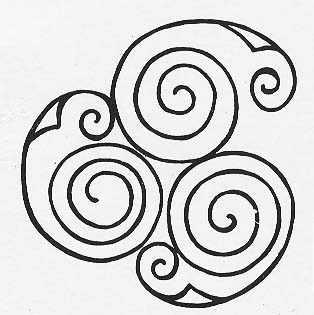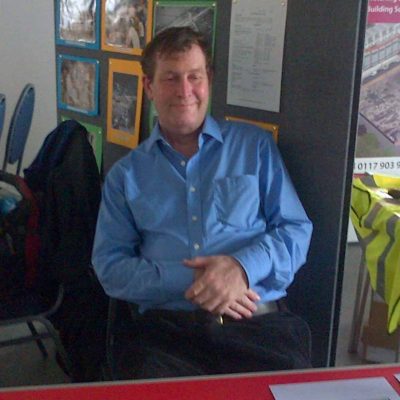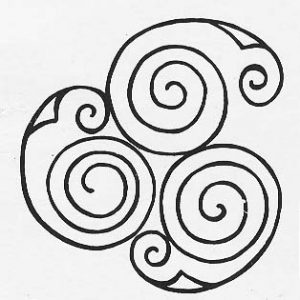

James Russell is standing down as Treasurer to BAAS after 40 years. Sadly he was unable to attend the AGM to give his talk, but Gundula Dorey read it on his behalf.
It is now 40 years since I was elected Treasurer of the then Bristol Archaeological Research Group in March 1979. As I step down from this role I have been asked to say something about my four decades in the post. I would like to start, however, by outlining how, and why, I became involved in archaeology in the first place.
I was born in Bristol in 1953 and have spent my entire life in the city, which, for all its faults, I consider one of the most historic, and characterful, in Britain. An only child, I was timid and physically feeble, useless at all sporting activities but keen on drawing and, after a slow start, a voracious reader. Interested in history and archaeology from the age of seven, I was soon making regular visits to Bristol City Museum and devouring such works as Sir Mortimer Wheeler’s “Archaeology from the Earth” and Eric S Wood’s “Collins’ Guide to Field Archaeology”. My real starting point, however, was a small book called “Looking and Finding” by the poet and ‘man of letters’ Geoffrey Grigson. Aimed at young people but written in a wholly unpatronising style, and with challenging reading lists after each chapter, this admirable work not only encouraged an inquisitive approach to my surroundings but opened my eyes to the delights of second hand bookshops, Ordnance Survey maps, and building my own museum. Armed, as Grigson advised, with my first two and a half inch O.S. map of North West Bristol (Sheet ST 57) I was able to seek out the hillfort on Blaise Castle Hill, where I scoured molehills and badger setts for flint implements and Iron Age and Roman pottery; and the Roman site at Sea Mills, where gardens yielded sherds of glossy red Samian ware and a complete amphora handle.
I was fortunate in having an indulgent father who enjoyed driving and was happy to take me around the Bristol area at weekends looking at old churches and archaeological sites. Then on the opening of the first Severn bridge in September 1966 we were able to extend our range across the Severn to explore Caerwent, Caerleon, Tintern Abbey and the castles at Chepstow and Raglan.
In 1964 I passed the 11 plus and obtained a place at Bristol Cathedral School, an excellent establishment where I remained happily until 1970. The school occupies the domestic quarters of the medieval St Augustine’s Abbey, and its walls are studded with intriguing Romanesque and Gothic architectural fragments. One day, during my final year at the school, I was passing a retaining wall on Lower College Green which was under repair. Turning over a large block of freestone I found that it was in fact carved with a well preserved 14th Century female face, preserving much of its original paint – my first major find.
Between 1971 and 1974 I studied for a Combined Honours degree at Bristol University, comprising Archaeology and Ancient History, History of Art and English. The Archaeology course, which had a strong classical bias, was largely taught by Keith Branigan, who took us on summer training excavations at Nazareth House, Sea Mills (1972) and the Roman site at Gatcombe (1973 and 74). During vacations I did several spells of voluntary work at Bristol City Museum, where I encountered for the first time the austere and somewhat forbidding figure of Leslie Valentine Grinsell, then nearing retirement as Curator of Archaeology.
By the time I graduated in 1974 I had done enough excavation to realise that much as I enjoyed it I was not physically strong enough to consider life as a digger on a full time basis. I decided therefore to accept a routine clerical post in the Inland Revenue and pursue archaeology in my spare time. Between 1975 and 1979 I served as Curator of the small private archaeological museum belonging to the University of Bristol Speleological Society. With the help of members of a local history group I was able to carry out my first solo excavation, on the site of a medieval almshouse next to Westbury on Trym parish church. It was later fully published in BAA vol 7.
From 1976 to 1978 I undertook an Extra Mural Certificate course in Field Archaeology and Landscape History, the main tutors for which were Joe Bettey and Peter Fowler. A stimulating lecturer and writer, witty and ascerbic, Fowler was at the time a dominant figure in Bristol Archaeology. Through the course I got to know a number of experienced amateur archaeologists as well as our current Hon Secretary, Rob Iles, then the County Archaeologist for Avon. Once I had completed the course I was free to become more closely involved in the work of BARG, which I had joined some years previously, and in the Spring of 1979 was invited to take over from Arthur Selway as Treasurer. The AGM that year was rendered memorable by a lively farewell address from Peter Fowler who was leaving Bristol to take up a more prestigious post as Secretary of the Royal Commission on Historic Monuments. He may have felt he could safely burn his boats, as his highly critical survey of the local scene was punctuated by doggerel verses lampooning prominent members of the Group and City Museum staff.
On taking over the treasurership it became apparent to me that BARG was run on a shoestring. We had little capital and our main sources of income were subscriptions and publication sales. In retrospect it is remarkable that we were able to keep running for the next 16 years, producing a programme of lectures and other events as well as regular Bulletins (edited by myself from1981) and a (more or less) annual Journal, developed and initially edited by Rob Iles. I did my best to raise a little extra income by giving talks to other societies and, when attending day schools and conferences, taking with me a heavy bag of publications and membership leaflets. Our financial problems were eventually resolved in1995 by a generous bequest from Leslie Grinsell.
Our early difficulties were eased somewhat by the fact that for many years the Group was firmly based in Bristol City Museum. Many curatorial staff, such as Leslie Grinsell, David Dawson, Mike Ponsford, Georgina Plowright and Nicholas Thomas, took an active interest in the Group, while all lecture meetings took place free of charge in the Museum, normally in the first floor schools room. In addition to talks there were regular ‘stores evenings’ in the Museum basement, which offered a chance to process finds and research the reserve collections. In 1996, for example, I discovered in the stores the drawings and notes left by a young engineer, Thomas Marsh, who had in 1837 excavated a Roman villa in Newton St Loe which had been exposed by the Great Western Railway; from these records I was able to produce a full account of the villa, published in BAA Volume 9. All too often, however, these evenings served primarily as an opportunity for informal socialising; they usually ended with a visit to a nearby hostelry; either the Princes Bar in Park Row or the tiny Eldon House on Clifton Hill, where David Dawson and his close associates monopolised the bar billiards table. While David remained Curator he regarded ‘stores evenings’ as part of his social life and was happy for them to continue. His successors were, however, less enthusiastic and we were gradually eased out, first from the basement and eventually from the Museum altogether, moving our lectures first to St. Matthew’s Church in Kingsdown and, more recently, to the Apostle Room in Clifton Cathedral.
In terms of fieldwork the 1980s were undoubtedly my most active decade. While increased resources were being invested in Archaeology by national and local government the response to development threats was still patchy and there was a good deal of scope for amateur involvement. In those days there was much less emphasis on ‘Health and Safety’ and ‘Site Security’ and it was possible to wander onto building sites at evenings and weekends without being challenged. With the invaluable collaboration of John Hunt and a small group of enthusiastic volunteers we were able to excavate a number of sites in the Bradley Stoke area – two Roman settlements and a major medieval site at Parsonage Field, where we spent nearly a year in 1984-85 salvaging a series of medieval and later house sites from the developer. This work was summarised in BAA vol 5.
The 1980s also saw a major training excavation at Bickley, Cleeve, the property of our member, Mary Campbell. In 1981 David Dawson and Oliver Kent established a Ceramics Project in this wooded enclave with the aim of building kilns for firing replica medieval and later pottery. Digging holes for the first kiln unexpectedly revealed remains of a genuine medieval farmstead. From 1982 to 1989 this was developed as a training excavation by Mike Ponsford, attracting a good number of mostly young volunteers each summer and was published in the SANHS Proceedings vol 146.
After 1990 the archaeological scene was transformed by the advent of ‘PPG 16’ which integrated archaeology into the planning process; henceforth development sites were to be routinely evaluated and, where necessary, excavated in advance by mainly professional units. There were now far fewer excavation opportunities for amateurs, and I increasingly turned to other forms of research and non-excavational fieldwork. In 1993 I published privately a detailed topographical study of the Civil War defences of Bristol. In 2001 I produced an account of the archaeology of the Parish of Clifton, including a survey of the ancient field system on Clifton Down begun many years earlier with Rob Iles ( published in Bristol & Avon Archaeology Vol 18).
Around the same time I was able, with the assistance of our member Patricia Morgan, to research the history of the little known medieval nunnery at Barrow Gurney. In 2008, along with Mike Ponsford, I assisted Jon Cannon and Prof. Nicholas Orme with the preparation of a Bristol Record Society volume on the Church and College at Westbury on Trym; this included plans and drawings of the unusual crypt chapel below the east end of the church, which I had been able to access and study for the first time the previous year. Since the late 1980s I have developed a special interest in the archaeology of parks and gardens, starting with a study of Stoke Park overlooking the M32 which appeared in “Bristol & Avon Archaeology” vol 8. I established a close relationship with the Avon Gardens Trust, publishing many articles on local historic estates in their Newsletters and Journals.
Time does not permit a detailed account of the many summer activities I have enjoyed with BARG/BAARG/BAAS over the years. For many years until 2014 I was able to lead guided walks several times a year around Bristol and its suburbs. There have also been many weekend field trips to the Cotswolds, Mendip and South Wales, led mainly by Bob Williams and Mike Gwyther. Particularly memorable was our 1999 “White Horse Day”, an excursion to the Berkshire Downs revisiting the sites described in a rare booklet by Leslie Grinsell.
My interest in drawing and draftsmanship meant that I was able to illustrate many of my publications myself. In addition I became a keen photographer and for many years confounded members of BAAS at successive Christmas parties with a photographic quiz of local landmarks so often tantalisingly familiar.
As members will know I have suffered a number of health problems over the years. Soon after leaving university I began to experience a gradual stiffening of my spine, later diagnosed as ankylosing spondylitis. In 1998 I broke my neck in a fall and in 2009 was diagnosed with kidney failure which has since required regular dialysis. I managed to bounce back from these difficulties, but in March 2015 suffered a serious spinal injury which put me in hospital for the best part of a year. From this I have only partially recovered and my mobility has suffered, particularly in the past 12 months, making it increasingly difficult to get to meetings.
I am extremely grateful for all the good friends I have made in BAAS over the years, and particularly to Gundula Dorey for her help and support over the last few difficult years. I am indebted to Steve Hastings for coming forward to take over my role as Hon Treasurer. I hope to continue to take an active interest in BAAS for many years to come and wish it all the best.
The Committee and BAAS members would unanimously like to say a huge thank you to James for a lifetime’s endeavour to the running of BAAS, his contribution as Treasurer and for his vast archaeological knowledge and fieldwork that he carried out in Bristol and the surrounding area. Thank you also to Gundula for reading James’ talk on his behalf.

